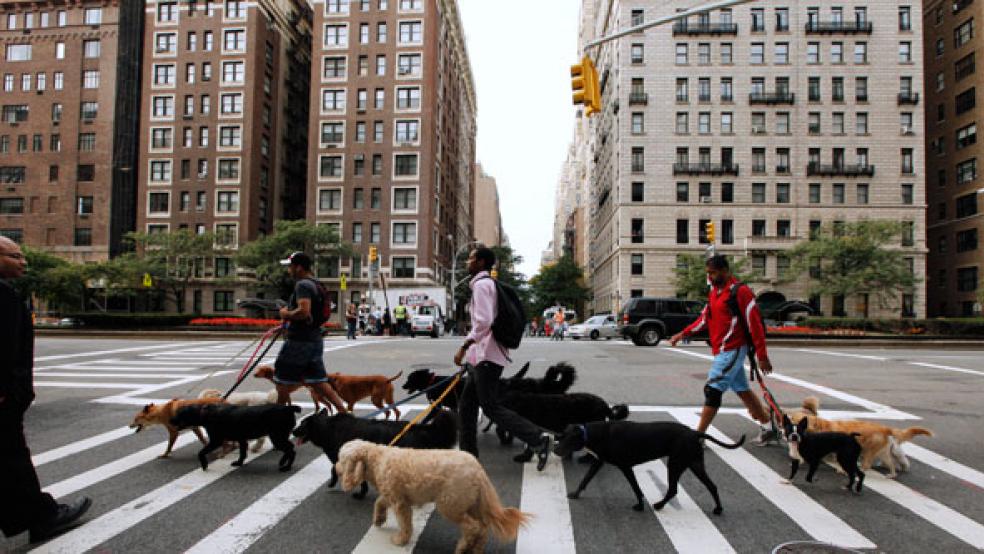Before he moved to his current U Street neighborhood — and to Dupont Circle before that — Doug Rogers knew exactly how long it would take to walk to the Metro, the grocery store, the pharmacy and local restaurants.
 “It was a big draw,” says Rogers, a fraud investigator and former president of the Dupont Circle Citizens Association.
“It was a big draw,” says Rogers, a fraud investigator and former president of the Dupont Circle Citizens Association. A Texas native, Rogers put a premium on the District’s walkable neighborhoods. “In Texas, you drive everywhere. People would ask me, ‘How’s living in the big city?’ It seems counterintuitive, but it actually feels like we live in a small town. Being able to walk helps create a neighborhood feel.”
“Walkable” is a feature sparking sales and energizing future development and redevelopment, according to a recent report by a George Washington University professor that calls the Washington area a national model for compact urban areas where residents can live and work without cars.
“The strongest housing market is in walkable urban areas,” says Christopher B. Leinberger, author of the report, “DC: The WalkUP Wake-Up Call.” “That’s where the demand is.”
The popularity of walkable neighborhoods is also reflected in real estate listings, according to local experts. One major residential real estate service, Zillow, even routinely includes “walk scores” in its listings. And many local real estate agents are quick to point out what is within walking distance of a property.
“We always talk about proximity to Metro,” says Lindsay Reishman, principal broker of Dupont Circle-based Lindsay Reishman Real Estate, noting that walkable neighborhoods are appealing to all demographics, from empty-nesters to young professionals.
RELATED: The New Boom Towns: Suburbs Get City Makeovers
Regionally significant walkable urban areas — referred to in the report as “WalkUPs” — have cultural amenities such as museums and libraries, offices, shopping, restaurants and different types of housing. There are 43 such neighborhoods in the Washington area, spanning seven counties.

While they share characteristics, they don’t all look the same. Some, such as Capitol Hill and Capitol Riverfront, are near downtown Washington. There is urban commercial — Van Ness, Georgetown and Adams Morgan are examples. Others are in suburban town centers such as Bethesda, Clarendon and Frederick, or in a strip commercial redevelopment, such as Bailey’s Crossroads and Friendship Heights.
Only 42 percent of the WalkUPs are in the District. The rest are in the suburbs, according to the report. National Harbor, New Carrollton, Virginia Square and Rosslyn are among the neighborhoods that make the list. The growth in the suburbs is pretty dramatic, given that there were only two walkable areas there in 1990. “There’s no reason to add a square mile of development,” says Leinberger, who is also a senior fellow at the Brookings Institution and president of Locus, a coalition of real estate developers and investors and a project of Smart Growth America. “Where there is pent-up demand is in these [walkable, urban] areas.”
Of course, “walkable urban isn’t for everyone,” he says. “The good news for those who want to buy in the drivable suburbs is that houses are quite cheap. . . . In the fringe suburbs of Washington, prices in some neighborhoods have dropped 50 and 60 percent.” The price of buying in a regionally significant, walkable urban area is higher, Leinberger notes. But there are cost-savings in transportation by not having to maintain a car (or cars). And there’s a higher return on the investment in the long run, says Leinberger.
For example, a place with good walkability, on average, commands $10.60 per square foot more annually — almost 60 percent more — in residential rent than places in car-centered suburbs, according to the report. For-sale housing is $157.68 per square foot — about 70 percent more than in car-dependent areas — in WalkUPs.
A 2011 survey by the National Association of Realtors found that 58 percent of respondents favor walkable, mixed-use neighborhoods over neighborhoods that require more driving between home, work and recreation. Rental apartment developers are also seeking walkable, urban areas, says Leinberger. In the 1990s, 12 percent of the region’s new rental apartment space was built in WalkUPs. Today, it’s 42 percent, Leinberger finds.
North Bethesda Market, for example, has apartments, a Whole Foods, a fitness center and restaurants near the White Flint Metro. And AVA H Street — a 140-unit complex — is near Union Station, Bike Share and Zip Car locations, restaurants and other amenities, including a Giant opening next year. Louis at 14th/U, a residential and retail development in the U Street Corridor, and District, a seven-story mixed use building at 14th and S Street NW are under construction.
Rents and home values are even higher in walkable urban areas that are clustered together, such as Dupont Circle, Georgetown, Adams Morgan, Kalorama, West End, Columbia Heights, U Street, Logan Circle and downtown, the report says. In Virginia, Clarendon, Virginia Square, Courthouse and Ballston form a walkable urban district.
With the proliferation of bike- and car-sharing programs, living car-free has never been more convenient. Most (33 of the 43 regionally significant WalkUPs) are near rail transit or will be when construction is complete. Being within a mile (and therefore an easy walk) to the Metro “makes living very easy,” says Marcie Sandalow, an agent with Chevy Chase-based Evers and Company Real Estate. “Clients are willing to pay more for it.”
Zillow has included Walk Scores in its listings since 2009, just after Walk Score was founded. The Seattle-based company ranks neighborhoods on a scale of 0, meaning very car-dependent, to 100, a “walker’s paradise” where most errands can be done without a car. Buyers are also relying more on smart phone apps that show the nearest walkable amenities, from elementary schools to coffee shops. As real estate agents are quick to tell house hunters, a home’s proximity to such destinations may end up meaning just as much as its address. “People love being able to wander up for an ice cream after dinner, or to let the kids walk to see a movie,” Sandalow says.
The shift away from neighborhoods where residents must drive to stores and offices is evident in local government smart-growth policies and community plans, according to Leinberger’s report. In the suburbs especially, local governments have changed zoning rules and have encouraged projects that combine high-density residential with retail and office space to make a walkable core.
That’s one of the main goals of the form-based code being used along Columbia Pike, says Takis Karantonis, executive director of Arlington-based Columbia Pike Revitalization Organization. “We want this to be a walkable corridor,” he says. “We want mixed uses. It’s more vibrant. It’s friendly.”
That’s also at the heart of the plan for Tysons. And while some critics have raised doubts about how walkable the area will become, Leinberger is optimistic. “Rome was not built in a day,” he says. He and other experts are encouraged by the plans to open four new Metro stations. Bike lanes are being built. Street parking, which acts as buffer to pedestrians, will also be included. And retail is being built to the sidewalk. It’s more pedestrian-friendly to walk past buildings than parking lots.
RELATED: 5 Ways the Student Loan Bubble Mirrors the Housing Crisis
In the end, Tysons property owners, including nearby residents, embraced higher-density mixed uses, says Leinberger: “They realized, ‘We have to urbanize to get back into the game.’”
Walkability is also seen as the key to the projects around the White Flint Metro and in Bethesda, says Evan Goldman, vice president of development at Federal Realty Investment Trust, which developed Bethesda Row and is developing several projects along Rockville Pike, including Pike and Rose, a 24-acre, transit-oriented development at White Flint’s Metro station.
The formula of the Rockville-based developer’s strategy is based on how far people will walk: about half a mile (a 10-minute walk) to offices and Metro, and a quarter of a mile (about a five-minute-walk) to daily destinations such as grocery and drug stores. The company builds accordingly. But it’s not just about distance. Success depends on how appealing a walking environment is — whether there are trees and short blocks, for example — Goldman and other experts agree. If traffic is whipping past, if the sidewalks are adjacent to empty parking lots (or nonexistent), people won’t walk, they say.
Take Dan Hoffman, a government project manager, who could walk from his Randolph Hills neighborhood to the White Flint Metro station in 20 minutes but doesn’t because of physical obstacles (a fence) and traffic.
When the projects are complete, says Hoffman, chairman of the White Flint Implementation Advisory Committee, “Our neighborhood will be able to walk to dining, shopping, offices.” And the walk to the Metro will become much safer and more appealing, Hoffman says.
With its grid of streets and moderate-size blocks, the District has always been inherently walkable. But, says Harriet Tregoning, director of the D.C. Office of Planning, “We haven’t always had so many places to walk to. We have more convenience retail. More and more, people can meet their daily needs in their neighborhoods.”
From the Safeway being rebuilt in Petworth to new businesses in Columbia Heights, walkable amenities are being added in neighborhoods across the District, says Tregoning. “We’re lucky that we have so many walkable neighborhoods,” Tregoning says. “I think a single indicator of a successful city is its walkability.”
This article originally appeared in The Washington Post.




